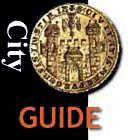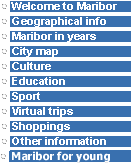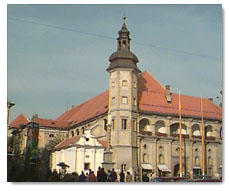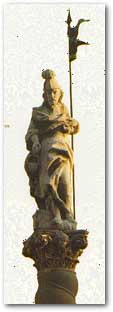

Grad(The Castle) - Partizanska cesta(Partizanska street) - Ulica talcev - Presernova ulica(Presernova street) - Partizanska cesta(Partizanska street) - Kidricev trg(Kidric square) - Tomsiceva ulica(Tomsic street) - Mestni park(Town Park) - Trg generala Maistra(Maister square)
![]() Grad
Grad
 In addition to the main Church,
the Castle [1] is Maribor's chief architecturral
monument. It was built in 1478 by Emperor Friedrich
III, in the northeastern part of town, in order to
fortify the corner of the town wall. After the Turkish
seige of Maribor in 1532, they erected in the place of
the corner tower a brick building (bastille) under the
supervision of the celebrated fortifications
master-builder Domenico dell' Allio (1556-1562).
Later, the Castle was inhabited by a rich nobleman. In
1655 a Laurentine chapel
was added at the south side of the Castle. This addition
made the facade more dynamic. In 1661 a triangular front
was added. The owners, the Counts Khisli, added
land to the Castle. The coffee house Astoria and
movie theatre Partizan were once the Castle
outhouses and the Castle courtyard. In the eighteenth
century, the new Castle owners, the Counts Brandis,
rebuilt its western side. From 1741-1750 on, they added
the grand staircase, which was richly adorned with
sculptures. In this way the entire building took on a Rococo
ambience. Above the Castle entrance stands the coat of
arms of the noble families Brandis and Trauttmannsdorf.
The focal point of the Castle is the Festival Hall
(usually named The
Knights' Hall, though the name is anachronistic),
with its lavish interior design. It was furnished by the
artists from the Quadri family and by Lorenz
Laurigo. At the top of the oval ceiling there is an
imposing painting of the mounted battle between the
Christian and the Turkish armies. It was painted in 1763
by the Graz artist J.M. Gebler. In the nineteenth
century, the Castle began to lose its original design.
Its three steeples were removed. The one that was left is
adjacent to the chapel. At its southeastern comer, its
stone "Castle Gate" was removed. In 1871, when
they were erecting a secondary school building (the
present-day secondary humanistic school in Trg generala
Maistra), they built Grajska ulica through the Castle
courtyard. In 1933 the building that was falling into
disrepair was bought by the town of Maribor; during
1937-1941, the building was renovated; in 1938
Pokrajinski muzej (the Regional Museum) took it over, and
it has remained here until the present day. Several
dignitaries had visited the Castle, or stayed there for
short periods of time, among them the Emperors Leopold
I and Karel VI, the Empress Maria Theresia;
the Russian heir to the throne Tsar Pavel I, and Pope
Pius VI. In 1846, the great pianist Franz Liszt
gave a concert in Festival Hall. In 1941 Adolf Hitler
spoke here, advocating ethnocide: " Make me this
country German again!". The western wall of the
administrative section of the Museum bears an oval
memorial plaque to Professor Franjo Bas
(1899-1967), founder of the present-day Museum and for
many years its innovative director.
In addition to the main Church,
the Castle [1] is Maribor's chief architecturral
monument. It was built in 1478 by Emperor Friedrich
III, in the northeastern part of town, in order to
fortify the corner of the town wall. After the Turkish
seige of Maribor in 1532, they erected in the place of
the corner tower a brick building (bastille) under the
supervision of the celebrated fortifications
master-builder Domenico dell' Allio (1556-1562).
Later, the Castle was inhabited by a rich nobleman. In
1655 a Laurentine chapel
was added at the south side of the Castle. This addition
made the facade more dynamic. In 1661 a triangular front
was added. The owners, the Counts Khisli, added
land to the Castle. The coffee house Astoria and
movie theatre Partizan were once the Castle
outhouses and the Castle courtyard. In the eighteenth
century, the new Castle owners, the Counts Brandis,
rebuilt its western side. From 1741-1750 on, they added
the grand staircase, which was richly adorned with
sculptures. In this way the entire building took on a Rococo
ambience. Above the Castle entrance stands the coat of
arms of the noble families Brandis and Trauttmannsdorf.
The focal point of the Castle is the Festival Hall
(usually named The
Knights' Hall, though the name is anachronistic),
with its lavish interior design. It was furnished by the
artists from the Quadri family and by Lorenz
Laurigo. At the top of the oval ceiling there is an
imposing painting of the mounted battle between the
Christian and the Turkish armies. It was painted in 1763
by the Graz artist J.M. Gebler. In the nineteenth
century, the Castle began to lose its original design.
Its three steeples were removed. The one that was left is
adjacent to the chapel. At its southeastern comer, its
stone "Castle Gate" was removed. In 1871, when
they were erecting a secondary school building (the
present-day secondary humanistic school in Trg generala
Maistra), they built Grajska ulica through the Castle
courtyard. In 1933 the building that was falling into
disrepair was bought by the town of Maribor; during
1937-1941, the building was renovated; in 1938
Pokrajinski muzej (the Regional Museum) took it over, and
it has remained here until the present day. Several
dignitaries had visited the Castle, or stayed there for
short periods of time, among them the Emperors Leopold
I and Karel VI, the Empress Maria Theresia;
the Russian heir to the throne Tsar Pavel I, and Pope
Pius VI. In 1846, the great pianist Franz Liszt
gave a concert in Festival Hall. In 1941 Adolf Hitler
spoke here, advocating ethnocide: " Make me this
country German again!". The western wall of the
administrative section of the Museum bears an oval
memorial plaque to Professor Franjo Bas
(1899-1967), founder of the present-day Museum and for
many years its innovative director.
At the northwestern
corner of the Castle complex stands the statue of Josip Jurcic (1844-1881). a
Slovene novelist who edited the political paper
"Slovenski narod" ("Slovene Nation")
in Maribor. The statue is the work of the sculptor Lojze
Kogovsek.
To the south the Castle
opens into Grajski trg (Castle Square), which narrows
sharply as it leads into Vetrinjska ulica.
Opposite the Castle Florian's
Monument is situated. Almost after a century (1970)
it again occupies its former position, where once the
town well stood. The location of the monument adds to the
balance and symmetry of the entire Square. The Orel
Hotel ("The Eagle') is a favourite local eating
and drinking place. In earlier times, it was the inn Pri
crnem orlu ("At the Black Eagle") and was
much frequented by wagon drivers passing through town.
The present facade of the Orel Hotel, as it faces the
Square and Slovenska ulica, dates back to 1929.